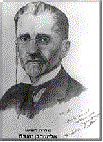The intrinsic value of the hebrew language goes well beyond its worth in linguistic terms . As the language of the Bible, Hebrew has long been considered 'the mother of all languages'. After centuries of slumber where it was strictly a liturgical and written language, Hebrew was literally reborn nearly a century ago in its original birthplace. Learning Hebrew opens up a whole new world to students and enriches them, from both a cultural and linguistic standpoint.
 Eliezar Ben Yehuda (1858-1922) led
the rebirth of Hebrew as a spoken language. After immigrating
to Eretz Israel in 1881, he began promoting the use of Hebrew
at home and in the schools. He created thousands of new words,
started two periodicals in Hebrew, co-founded the
Hebrew Language Committee (1890) and wrote the Complete Dictionary
of Ancient and Modern Hebrew, in 17 tomes, begun by him in 1910
and finished by his second wife and son in 1959.
Eliezar Ben Yehuda (1858-1922) led
the rebirth of Hebrew as a spoken language. After immigrating
to Eretz Israel in 1881, he began promoting the use of Hebrew
at home and in the schools. He created thousands of new words,
started two periodicals in Hebrew, co-founded the
Hebrew Language Committee (1890) and wrote the Complete Dictionary
of Ancient and Modern Hebrew, in 17 tomes, begun by him in 1910
and finished by his second wife and son in 1959.
Introduction
to the Hebrew Language
Hebrew is one
of the world's oldest languages, spoken and written today
in much the same way as it was more than two thousand years ago.
After ceasing to exist as a spoken language about 250 B.C., it
was reborn as a modern language in the 19th century, and today
it is the principal language of the State of Israel. Books,
newspapers, and magazines published in Israel today are written
in a Hebrew that is much the same as the language of the Bible.
For over three millennia Hebrew has been the religious, and often
the literary and secular, language of the Jewish people. A Semitic
tongue, it was spoken during the period of the migration of the
Patriarchs into Palestine and remained the language of the Jews
throughout the Old Testament period. In the post biblical period
Hebrew gradually gave way to Aramaic as the spoken language, but
continued throughout the centuries to serve as the
language of ritual and prayer.
The renaissance of Hebrew as a spoken language in the 19th century may be ascribed almost entirely to the efforts of one man: Eliezer ben Yehudah, who devoted his life to the revival of the language, and at the same time adapted it for modern use through the introduction of thousands of modern terms. Hebrew gradually came into use among the Jewish settlers in Palestine and became the official language of the State of Israel when that nation was created in 1948. Today about 3 million people speak Hebrew either as their maternal, adopted, or religious tongue.
The Hebrew alphabet of twenty-two letters (five of which have a different form when they appear at the end of a word) consists entirely of consonants. The language is written from right to left without vowels. Thus the word kelev (dog) appears as the Hebrew equivalents of, from right to left, k, l, and v. It is therefore impossible for one not familiar with the language to know how to pronounce a word from the way it is written. About the 8th century a system developed for indicating vowels through the use of small dots and dashes placed above and below the consonants. These signs are still in use today, but they are confined to school books, prayer books, and textbooks for foreigners, and are not to be seen in newspapers, magazines, or books of general use.
English
words of Hebrew origin include amen, hallelujah, sabbath, rabbi,
cherub, seraph, Satan, kosher, manna, shibboleth, and behemoth.
More recent contributions are kibbutz and sabra.
Hebrew is spoken/used in the following countries:
Israel, United States of America.
Language family
Family: Afro-Asiatic (Hamito-Semitic)
Subgroup: Semitic
Branch: Canaanitic
